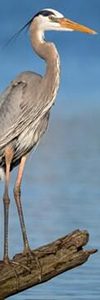| Great Blue Heron | ||
 |
Classification(s) : | Predator |
| Cat Name : | Heron | |
| Common Name : | Great Blue Heron | |
| Scientific Name : | Ardea herodias | |
| Other Name(s) : | ||
| Physical Description : | This sizable gray bird has long legs, a long “S” shaped neck and a heavy bill. The neck of the bird has a ruddy tone to it, and the head is crowned in white with a flashy black plume off the back of the head. Feathers and the neck and back are shaggy. On rare occasions all white birds that otherwise fit the physical description have been seen. |
|
| Physical Statistics : | Length: 38.2–53.9 Inches (97–137 Centimeters) |
|
| Behavior : | Herons nest in trees near water during the summer, but hunt the cats forests year round. They prefer to stalk calm waters, but will occasionally move away from water when it is necessary. |
|
| Social Organization : | Small Flocks will gather together when food is abundant. |
|
| Approval Level : | Mod; Being both a year-round threat and a species that runs in groups, Herons pose a great enough threat to a clan that the area moderator must be aware. | |
| Danger Level : | Medium (The young, old, and small are vulnerable); Herons prefer fish but are not so picky that they will pass up chances at warm-blooded prey. |
|
